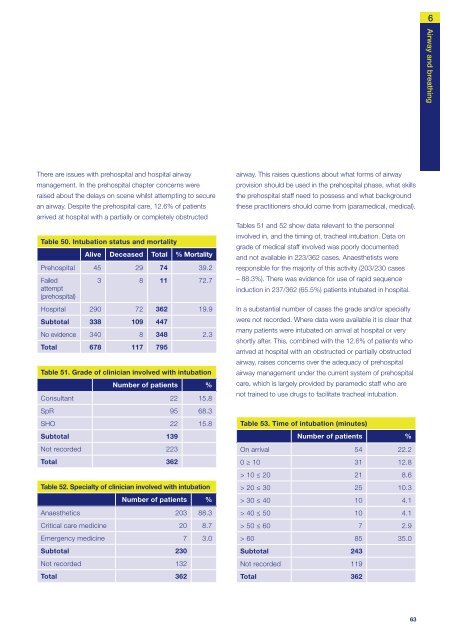NCEPOD: Trauma - Who Cares? - London Health Programmes
NCEPOD: Trauma - Who Cares? - London Health Programmes
NCEPOD: Trauma - Who Cares? - London Health Programmes
Create successful ePaper yourself
Turn your PDF publications into a flip-book with our unique Google optimized e-Paper software.
6Airway and breathingThere are issues with prehospital and hospital airwaymanagement. In the prehospital chapter concerns wereraised about the delays on scene whilst attempting to securean airway. Despite the prehospital care, 12.6% of patientsarrived at hospital with a partially or completely obstructedTable 50. Intubation status and mortalityAlive Deceased Total % MortalityPrehospital 45 29 74 39.2Failedattempt(prehospital)3 8 11 72.7Hospital 290 72 362 19.9Subtotal 338 109 447No evidence 340 8 348 2.3Total 678 117 795Table 51. Grade of clinician involved with intubationNumber of patients %Consultant 22 15.8SpR 95 68.3SHO 22 15.8Subtotal 139Not recorded 223Total 362Table 52. Specialty of clinician involved with intubationNumber of patients %Anaesthetics 203 88.3Critical care medicine 20 8.7Emergency medicine 7 3.0Subtotal 230Not recorded 132Total 362airway. This raises questions about what forms of airwayprovision should be used in the prehospital phase, what skillsthe prehospital staff need to possess and what backgroundthese practitioners should come from (paramedical, medical).Tables 51 and 52 show data relevant to the personnelinvolved in, and the timing of, tracheal intubation. Data ongrade of medical staff involved was poorly documentedand not available in 223/362 cases. Anaesthetists wereresponsible for the majority of this activity (203/230 cases– 88.3%). There was evidence for use of rapid sequenceinduction in 237/362 (65.5%) patients intubated in hospital.In a substantial number of cases the grade and/or specialtywere not recorded. Where data were available it is clear thatmany patients were intubated on arrival at hospital or veryshortly after. This, combined with the 12.6% of patients whoarrived at hospital with an obstructed or partially obstructedairway, raises concerns over the adequacy of prehospitalairway management under the current system of prehospitalcare, which is largely provided by paramedic staff who arenot trained to use drugs to facilitate tracheal intubation.Table 53. Time of intubation (minutes)Number of patients %On arrival 54 22.20 ≥ 10 31 12.8> 10 ≤ 20 21 8.6> 20 ≤ 30 25 10.3> 30 ≤ 40 10 4.1> 40 ≤ 50 10 4.1> 50 ≤ 60 7 2.9> 60 85 35.0Subtotal 243Not recorded 119Total 36263
















